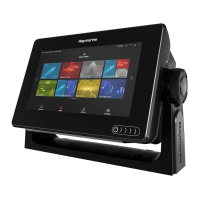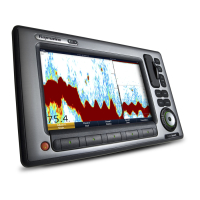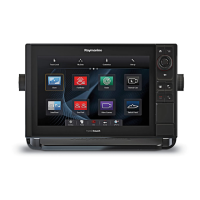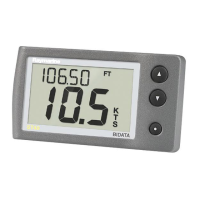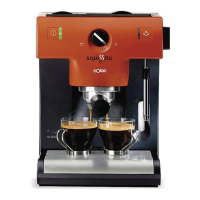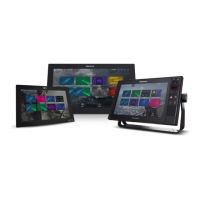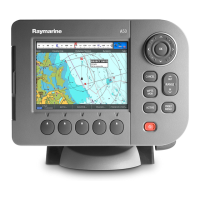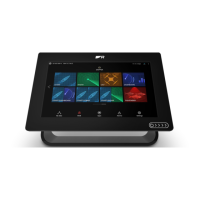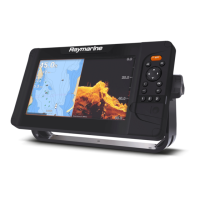Do you have a question about the Raymarine mn100 and is the answer not in the manual?
An overview of the Micronet display's self-sufficient, solar-powered design.
Technical details including dimensions, power, weight, and operating temperature.
Explains the display's power efficiency and battery status indicators.
Details the automatic power-saving feature and how to prevent system shutdown.
Instructions for connecting an external power source to the display unit.
Guidelines for the safe disposal of the device and its batteries.
Identifies and explains the various display elements and indicators.
Instructions for powering the Micronet system on and off.
How to adjust screen brightness and shutoff based on ambient light.
Explains system beeps for events like power-up, button presses, and alarms.
Describes specific alarms like Depth Shallow, Depth Deep, Wind High, XTE, and Waypoint Arrival.
Features for customisation: Keylock, Page Hiding, and Page Unhide.
Explains how to navigate through different chapters and pages using buttons.
Visual representation of the data display structure and page flow.
Introduces detailed descriptions of each data page and its information.
Explains Boat Speed, VMG, Log Distance, Trip Distance, and Maximum Speed displays.
Covers displays for Depth, Minimum/Maximum Depth, Apparent Wind Speed, and Angle.
Explains True Wind Speed, Angle, Direction, and Beaufort Wind Strength.
Covers displays for Heading, Speed Over Ground, and Course Over Ground.
Explains displays for Latitude, Longitude, Bearing/Distance to Waypoint, XTE, and TTG.
Covers Sea Temperature and the Race Timer function.
Explains displays for current time, date, and system voltage.
How to access the setup and calibration menu using button presses.
Describes navigating setup pages and editing configuration values.
Options for managing memory, including resetting trip distance and speed/depth maximums.
How to select units for speed, depth, wind, distance, and temperature.
How to configure shallow water, deep water, wind, and cross track error alarms.
Detailed configuration for shallow water, deep water, high wind, and cross track error alarms.
Configuring waypoint arrival alarm and speed calibration settings.
Setting depth offsets and configuring wind response, angle, speed, and shift.
Adjusting compass response, format, calibration, and magnetic variation.
Settings for networking, key lock, page hiding, time, and light control.
Adjusting display, resetting, and checking system/transmitter health.
Monitoring signal strength and status for NMEA, Mast Angle, and MOB sensors.
Setting keel or waterline offsets for accurate depth readings.
Steps to calibrate boat speed and distance against GPS SOG.
Calibrating wind angle offset and wind speed correction.
Process for deviating compass readings and setting correct heading.
Lists tools and parts needed for installing the display unit.
Advice on choosing a mounting location and safety considerations.
Step-by-step guide for mounting the display using a clip bracket.
Instructions for mounting the display on a surface without rear access.
Method for secure permanent mounting when rear access is available.
Guide for connecting the display to a 9-30V DC power source.
Basic cleaning and storage advice for the display unit.
Introduces common alarms and issues for troubleshooting.
Solutions for Low Battery, Lost Network, and data display issues.
Addresses issues like compass disagreement, zero speed readings, and alarm failures.
An overview of the Micronet display's self-sufficient, solar-powered design.
Technical details including dimensions, power, weight, and operating temperature.
Explains the display's power efficiency and battery status indicators.
Details the automatic power-saving feature and how to prevent system shutdown.
Instructions for connecting an external power source to the display unit.
Guidelines for the safe disposal of the device and its batteries.
Identifies and explains the various display elements and indicators.
Instructions for powering the Micronet system on and off.
How to adjust screen brightness and shutoff based on ambient light.
Explains system beeps for events like power-up, button presses, and alarms.
Describes specific alarms like Depth Shallow, Depth Deep, Wind High, XTE, and Waypoint Arrival.
Features for customisation: Keylock, Page Hiding, and Page Unhide.
Explains how to navigate through different chapters and pages using buttons.
Visual representation of the data display structure and page flow.
Introduces detailed descriptions of each data page and its information.
Explains Boat Speed, VMG, Log Distance, Trip Distance, and Maximum Speed displays.
Covers displays for Depth, Minimum/Maximum Depth, Apparent Wind Speed, and Angle.
Explains True Wind Speed, Angle, Direction, and Beaufort Wind Strength.
Covers displays for Heading, Speed Over Ground, and Course Over Ground.
Explains displays for Latitude, Longitude, Bearing/Distance to Waypoint, XTE, and TTG.
Covers Sea Temperature and the Race Timer function.
Explains displays for current time, date, and system voltage.
How to access the setup and calibration menu using button presses.
Describes navigating setup pages and editing configuration values.
Options for managing memory, including resetting trip distance and speed/depth maximums.
How to select units for speed, depth, wind, distance, and temperature.
How to configure shallow water, deep water, wind, and cross track error alarms.
Detailed configuration for shallow water, deep water, high wind, and cross track error alarms.
Configuring waypoint arrival alarm and speed calibration settings.
Setting depth offsets and configuring wind response, angle, speed, and shift.
Adjusting compass response, format, calibration, and magnetic variation.
Settings for networking, key lock, page hiding, time, and light control.
Adjusting display, resetting, and checking system/transmitter health.
Monitoring signal strength and status for NMEA, Mast Angle, and MOB sensors.
Setting keel or waterline offsets for accurate depth readings.
Steps to calibrate boat speed and distance against GPS SOG.
Calibrating wind angle offset and wind speed correction.
Process for deviating compass readings and setting correct heading.
Lists tools and parts needed for installing the display unit.
Advice on choosing a mounting location and safety considerations.
Step-by-step guide for mounting the display using a clip bracket.
Instructions for mounting the display on a surface without rear access.
Method for secure permanent mounting when rear access is available.
Guide for connecting the display to a 9-30V DC power source.
Basic cleaning and storage advice for the display unit.
Introduces common alarms and issues for troubleshooting.
Solutions for Low Battery, Lost Network, and data display issues.
Addresses issues like compass disagreement, zero speed readings, and alarm failures.



